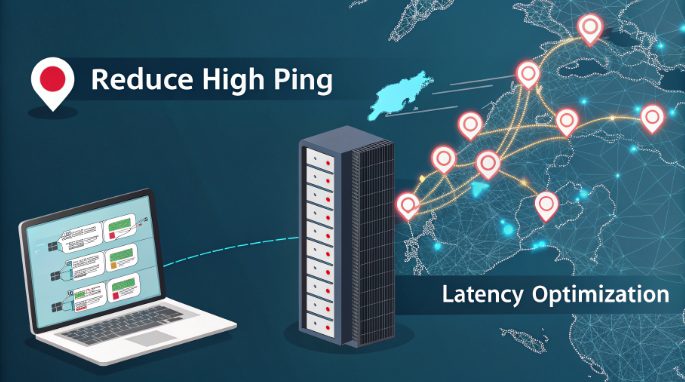How to Reduce High Ping and Latency for Japan Servers

For tech professionals dealing with Japan servers, high ping and latency issues can significantly impact application performance and user experience. This comprehensive guide explores advanced techniques for optimizing server connections and reducing network latency when working with Japanese hosting and colocation services.
Understanding Ping and Latency Metrics
Ping represents the round-trip time (RTT) for data packets between your client and the Japanese server. In technical terms, it’s measured in milliseconds (ms) and serves as a crucial indicator of network performance. When dealing with Japanese servers, acceptable ping values typically range from 50-150ms, depending on your geographical location.
- Ping < 50ms: Excellent connection (typically achievable within East Asia)
- Ping 50-100ms: Good performance (common from Southeast Asia)
- Ping 100-150ms: Acceptable for most applications (typical from US West Coast)
- Ping > 150ms: Requires optimization (common from Europe/US East Coast)
Root Causes of High Latency
Understanding the technical factors behind high latency is crucial for implementing effective solutions:
- Physical Distance: Light speed limitations in fiber optic cables
- Network Congestion: Oversaturated routes during peak hours
- Routing Inefficiencies: Suboptimal BGP paths
- Server Configuration: Improper TCP/IP stack settings
- DNS Resolution: Slow or distant DNS servers
Advanced Network Optimization Techniques
Implementing these technical optimizations can significantly improve your connection to Japanese servers:
1. BGP Route Optimization
Understanding and optimizing Border Gateway Protocol (BGP) routes is crucial for achieving lower latency:
- Implement BGP anycast routing for multiple server locations
- Use BGP communities to influence path selection
- Monitor AS path length and optimize routing policies
- Deploy route reflectors for improved path convergence
2. TCP Stack Tuning
Fine-tune your TCP/IP stack parameters for optimal performance:
- Adjust TCP window sizes:
net.ipv4.tcp_wmem = 4096 87380 16777216
net.ipv4.tcp_rmem = 4096 87380 16777216 - Enable TCP BBR congestion control:
net.core.default_qdisc=fq
net.ipv4.tcp_congestion_control=bbr - Optimize TCP keepalive settings:
net.ipv4.tcp_keepalive_time = 60
net.ipv4.tcp_keepalive_intvl = 10
CDN Implementation Strategy
Leveraging Content Delivery Networks (CDNs) effectively requires careful planning:
- Deploy edge servers in strategic locations across Asia
- Implement dynamic content caching with proper cache-control headers
- Use HTTP/3 and QUIC protocols for improved performance
- Enable Brotli compression for static assets
Advanced CDN Configuration
Optimize your CDN settings with these technical parameters:
- Configure origin shield locations near Japanese data centers
- Implement smart routing algorithms based on real-time latency data
- Enable TLS 1.3 with 0-RTT for reduced handshake latency
- Set up proper cache purging mechanisms using cache tags
Server-Side Performance Optimization
Implementing robust server-side optimizations is crucial for reducing latency in Japanese hosting environments:
Kernel-Level Tuning
- Network Buffer Optimization:
net.core.rmem_max = 16777216
net.core.wmem_max = 16777216 - IRQ Balance Configuration:
sysctl -w net.core.netdev_budget=600
echo 2 > /proc/irq/default_smp_affinity
Network Interface Configuration
- Enable Jumbo Frames (MTU 9000) on compatible networks
- Implement network interface bonding for redundancy
- Configure RSS (Receive Side Scaling) for multi-core systems
- Optimize interrupt coalescence settings
DNS Optimization Strategies
Proper DNS configuration can significantly reduce connection establishment time:
- Implement DNS prefetching:
<link rel="dns-prefetch" href="//your-japanese-domain.jp"> - Deploy local DNS resolvers in Japan:
- Use anycast DNS services
- Implement DNSSEC validation
- Configure proper TTL values
- Optimize zone file configurations:
- Use EDNS Client Subnet (ECS)
- Implement DNS-based load balancing
- Configure geo-DNS routing
Monitoring and Performance Analysis
Implement comprehensive monitoring solutions to maintain optimal performance:
- Deploy distributed monitoring agents:
- RTT measurement from multiple locations
- Packet loss detection
- Path MTU discovery monitoring
- Utilize advanced monitoring tools:
- smokeping for latency tracking
- mtr for route analysis
- iperf3 for bandwidth testing
Troubleshooting Guide for High Latency Issues
When experiencing persistent latency issues with Japanese servers, follow this systematic debugging approach:
Network Path Analysis
- Initial Diagnostics:
mtr -n -w -c 100 your-japanese-server.jp - TCP Connection Analysis:
tcpdump -i any host your-japanese-server.jp - Network Quality Testing:
for i in {1..10}; do ping -c 100 your-japanese-server.jp >> ping_stats.log sleep 60 done
Common Issues and Solutions
- Packet Loss:
- Check for network congestion
- Verify QoS settings
- Monitor buffer bloat
- Route Flapping:
- Analyze BGP announcements
- Check route stability
- Implement route dampening
Best Practices and Future Considerations
Maintain optimal performance with these long-term strategies:
- Regular Performance Audits:
- Monthly latency baseline checks
- Quarterly route optimization review
- Semi-annual infrastructure assessment
- Future-Proofing:
- Plan for IPv6 transition
- Consider quantum-ready encryption
- Evaluate emerging protocols
Conclusion
Optimizing Japan server connections requires a multi-faceted approach combining network engineering, system administration, and continuous monitoring. By implementing these technical solutions and maintaining vigilant oversight of your infrastructure, you can achieve and maintain low-latency connections to Japanese hosting and colocation services. Remember that optimization is an ongoing process that requires regular assessment and adjustment as network conditions and technologies evolve.
For optimal results, consider partnering with Japanese hosting providers that offer advanced networking features and maintain robust peering relationships with major Asian carriers. Continue monitoring emerging technologies and best practices in network optimization to ensure your infrastructure remains competitive in the rapidly evolving digital landscape.

